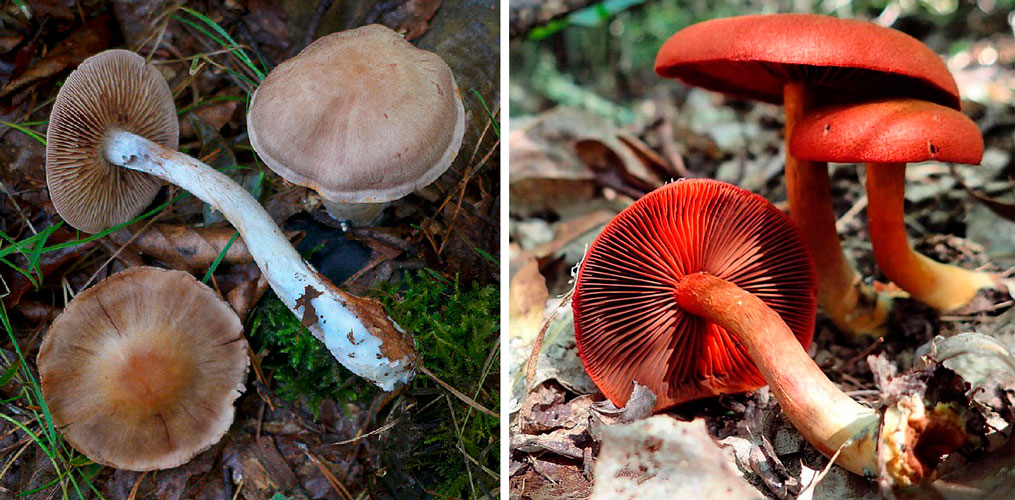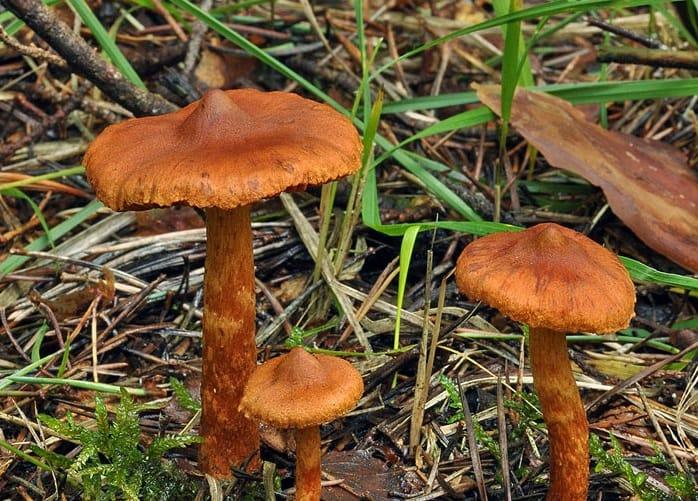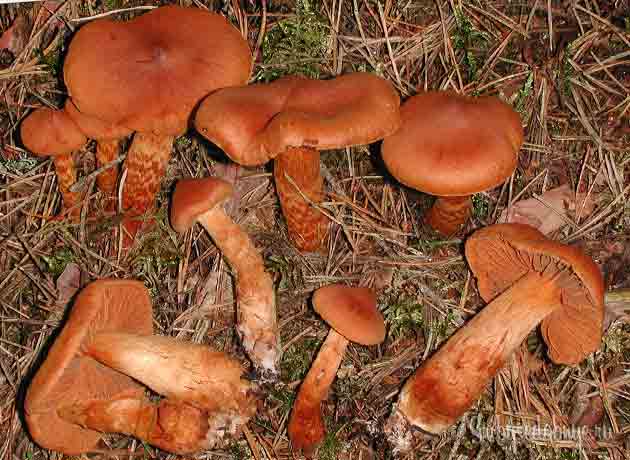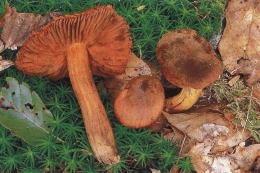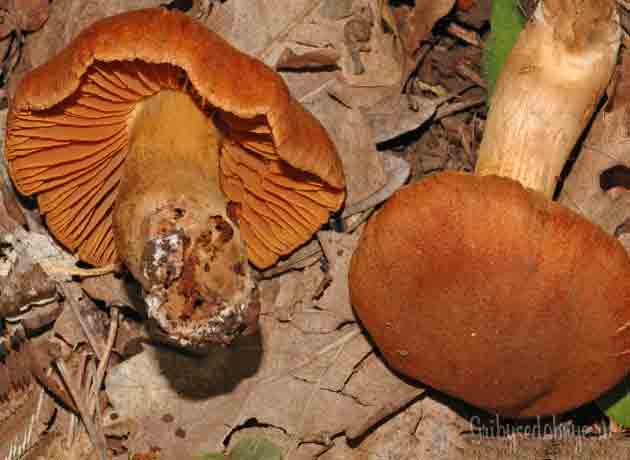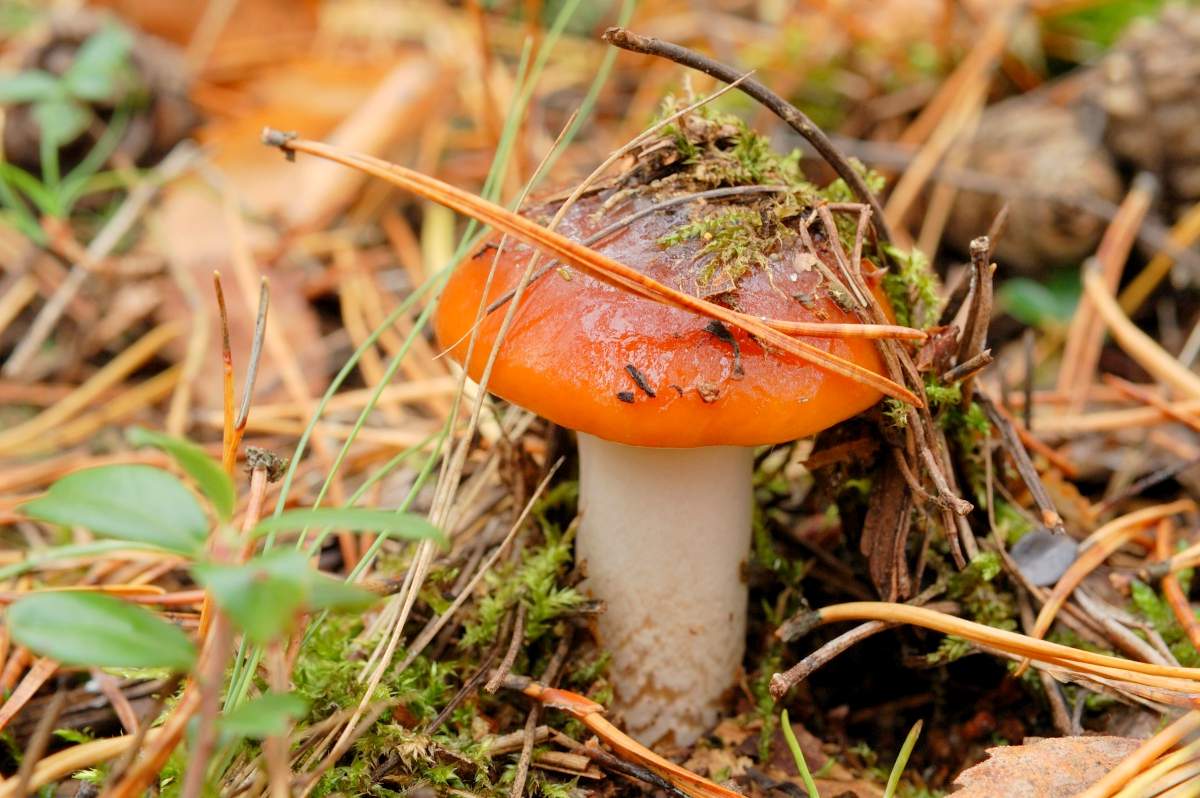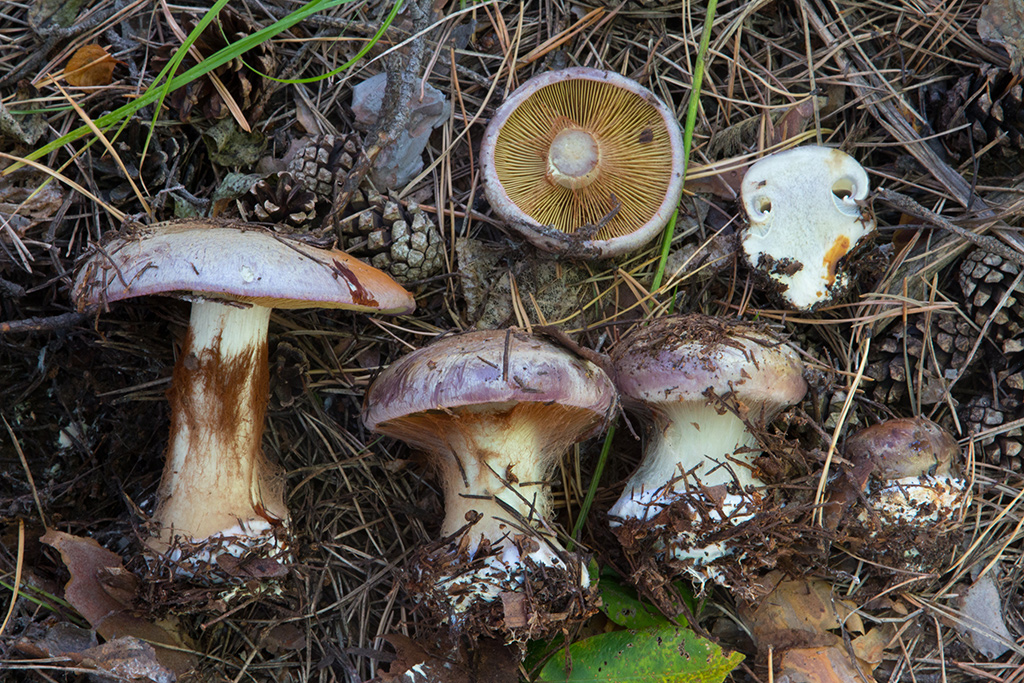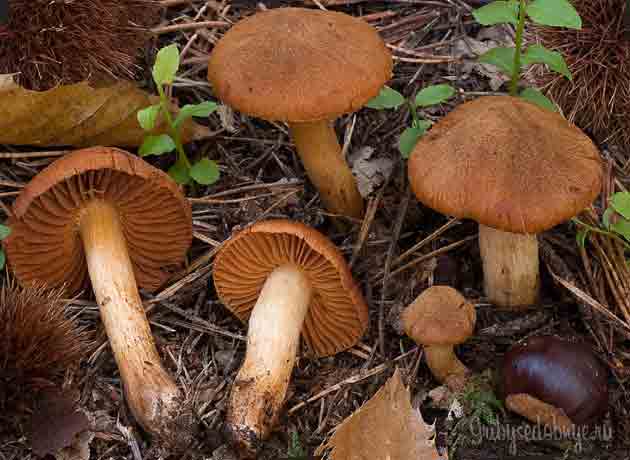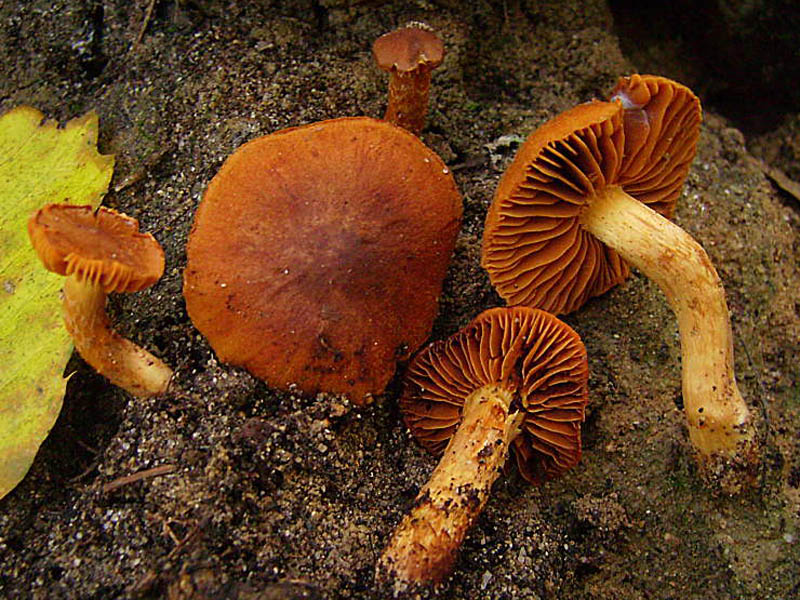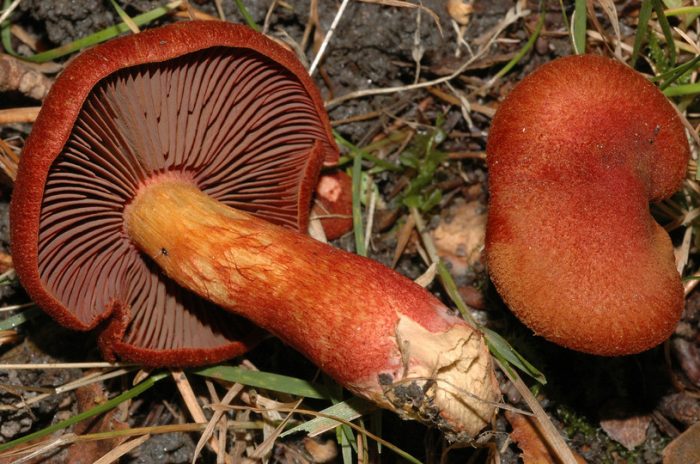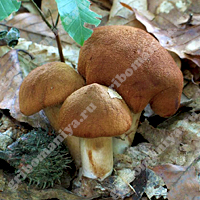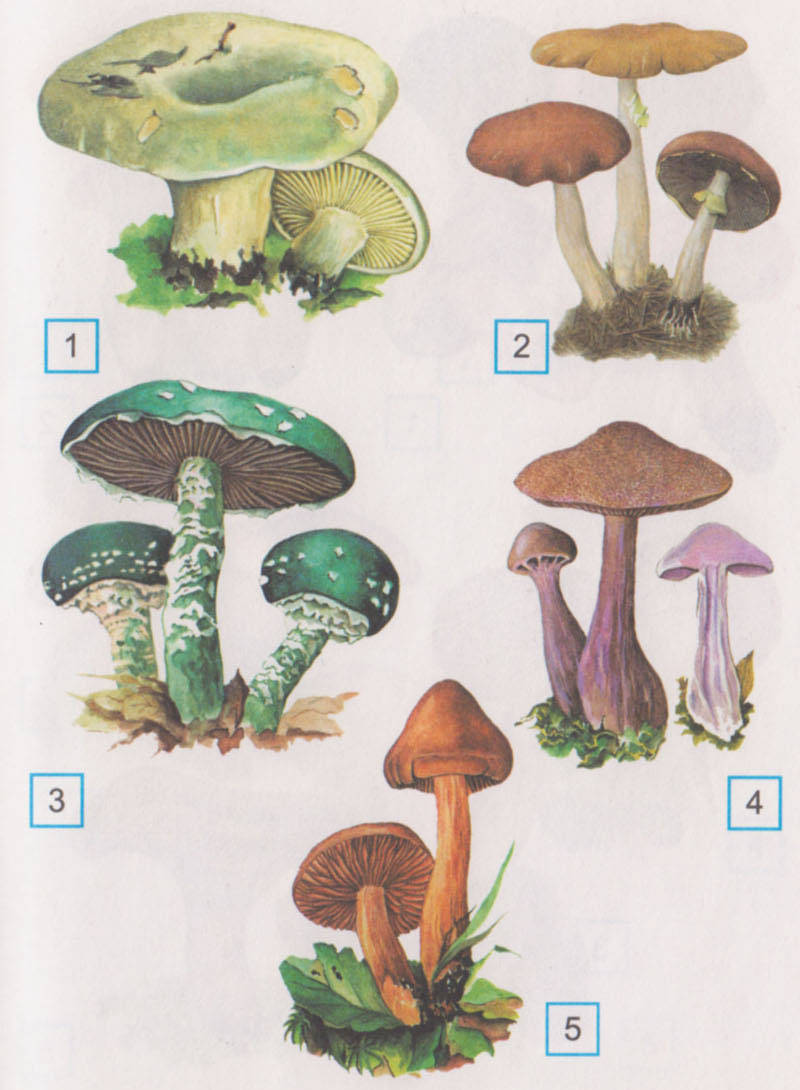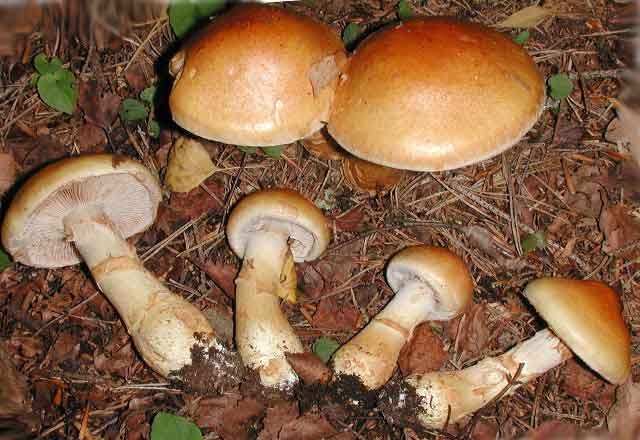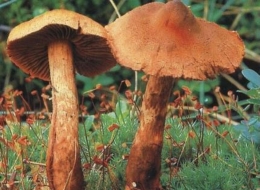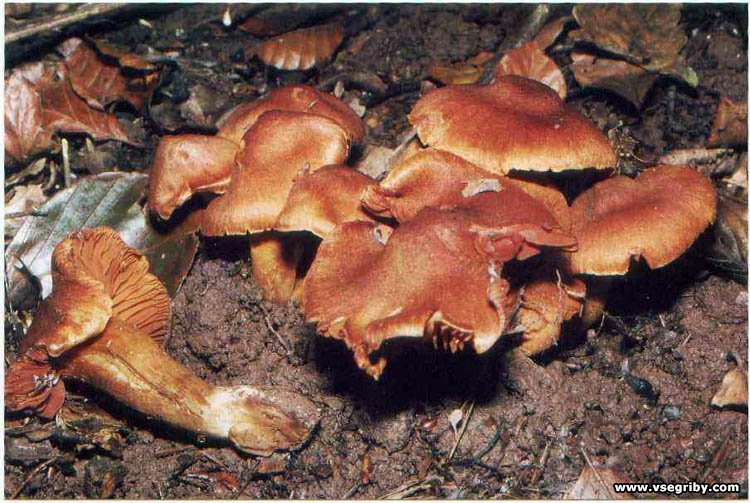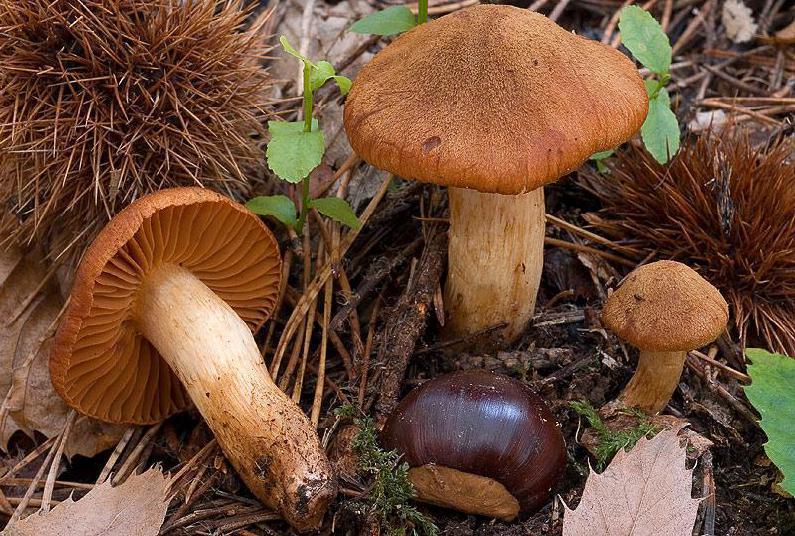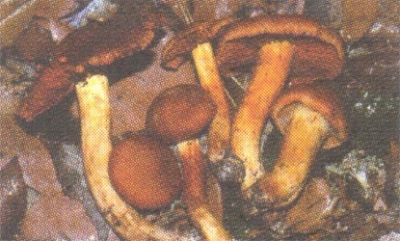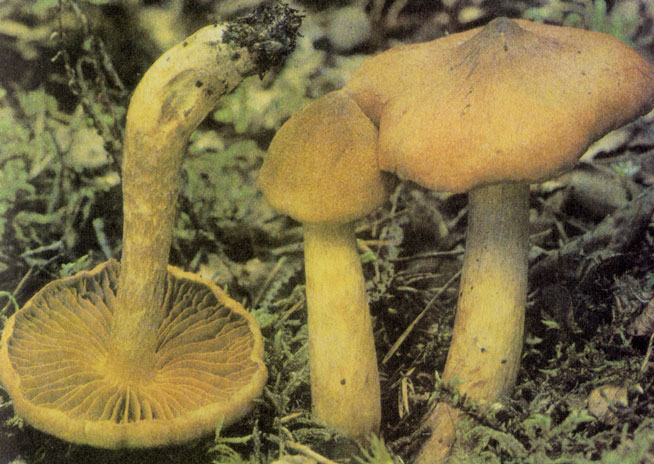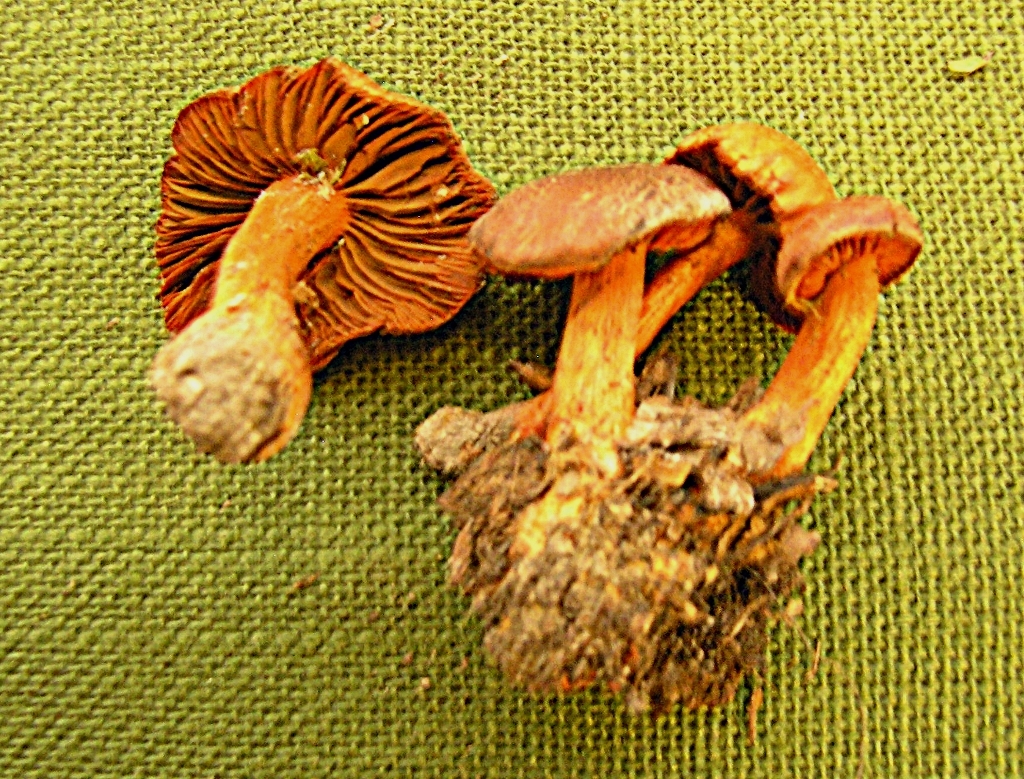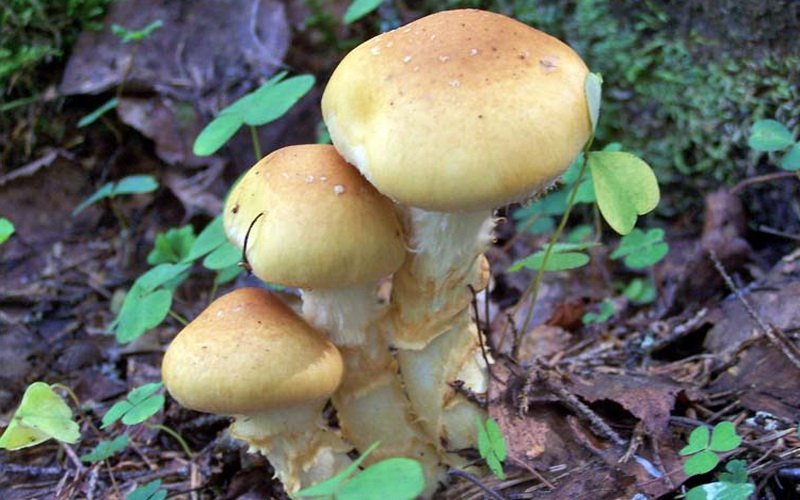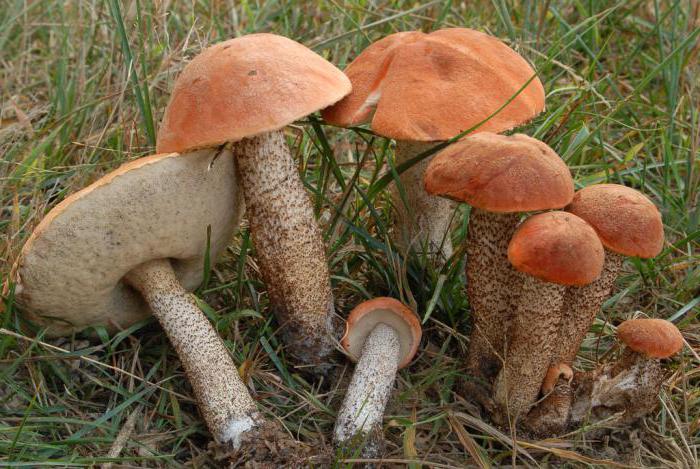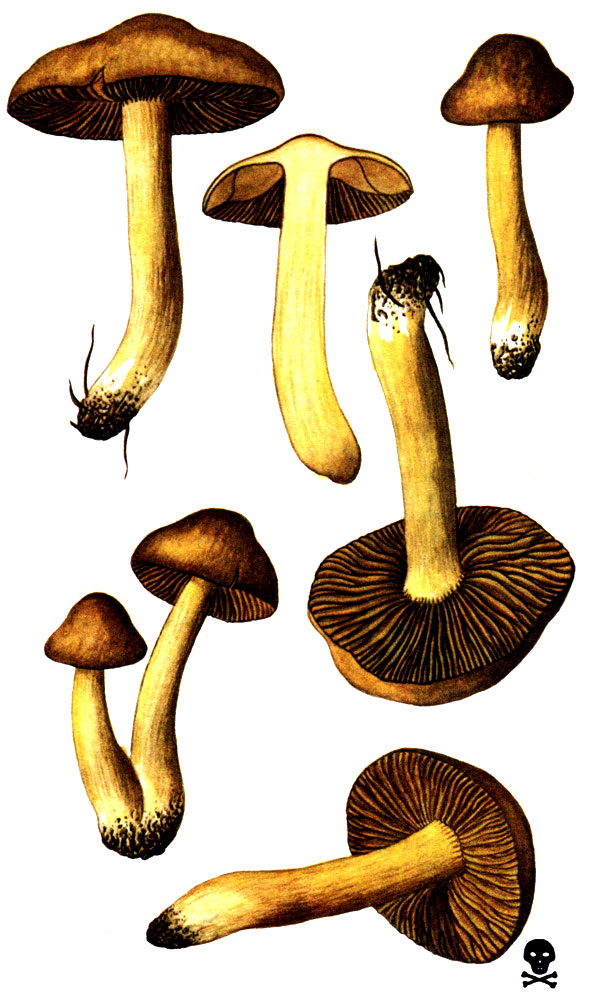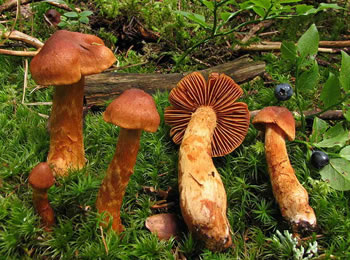Plush webcap (Cortinarius orellanus)
- Other names for the mushroom:
- Mountain webcap
- Cobweb orange-red
Other names:
Description:
Teddy webcap (Cortinarius orellanus) has a dry, matte cap, covered with small scales, 3-8.5 cm in diameter, hemispherical at the beginning, then flat, with an expressionless tubercle, orange or brown-red with a golden tint. All of them are distinguished by non-slip, always dry fruiting bodies, a silky felt cap and a slender, not thickened leg. The plates are colored orange to rusty brown.
Distribution: The plush webcap is a relatively rare species. In some countries, it has not yet been found. In Europe, it grows mainly in autumn (sometimes at the end of summer) in deciduous, and occasionally in coniferous forests. It forms mycorrhiza mainly with oak and birch. Most often appears on acidic soils. Learning to recognize this extremely dangerous mushroom is very difficult, since there are many similar species; because of this, even for a specialist, it is not easy to determine a teddy webcap.
Note:
Plush webcap - deadly poisonous. Contains the poisonous substance orellanin, which causes pathological changes in the kidneys. Signs of poisoning appear 3-14 days after ingestion of the mushroom. The mushroom retains its toxic properties after boiling in water or drying.
Teddy webcap, like other types of cobwebs, until 1960 was considered a harmless mushroom. The prevailing opinion was that among the huge number of cobwebs (more than 400 species grow in Europe alone) there are only bitter inedible species and relatively tasty species that are suitable for writing.
However, after frequent poisoning that took place in Poland, many of which were fatal, it was possible to establish that the culprit was a teddy spider web - a mushroom smelling of radish and pleasant to the taste. During chemical analysis, several poisonous compounds were found in its fruits - orellanin, cortinarin, benzoinin, etc. days. Then there is a rapid deterioration in the human condition, impaired renal function and death.
Description of the purple webcap
At favorable times, the cap of the purple spider web can grow up to 15 centimeters in diameter. At first, the shape of young cobwebs is hemispherical, but then it straightens out and reaches flat. A characteristic tubercle remains in the center of the cap.

Webcap purple
The color of the caps in young specimens is a beautiful dark purple, but gradually it fades, and older specimens already have white caps. The upper surface of the cap is fibrous-scaly. And in the lower part there are plates. The plates are wide, they are rarely located. The colors of the plates are purple.

Webcap purple

Webcap purple
The pulp is thick, at the break it acquires a bluish color. In general, it is very fragile and breaks easily in the hands. The pulp has a faint pleasant aroma.

The leg is long, becoming noticeably thicker towards the base. It is dense in structure. Traces of a spider web are visible on the leg. The color of the leg is dark purple.
Places of growth of the purple spider web
Basically, purple cobwebs settle in damp birch forests. You can find this type of mushroom under spruce and pine trees. Solitary specimens are more common, and fewer groups of these cobwebs are more rare.
Mushroom pickers can find the first fruiting bodies in August, and fruiting continues until October. It is more likely to meet this purple handsome man along forest swamps and lakes. In sunny glades and in mountainous areas, purple cobwebs do not grow.These mushrooms hide in a litter of fallen leaves and moss.

Appearance
The mushroom got its name because of the white "skirt" that falls on the leg and resembles a cobweb. The popular name "Pribolotnik" does not reflect the range of the species, although sometimes it is an absolutely swamp inhabitant. It grows in all types of forests on a variety of soils. This is an autumn genus, the peak of growth falls at the end of August-beginning of September.
The types of Spiderwebs are similar to each other in a number of ways:
- Cylindrical stem with downward extension.
- Remains of a private spider webbing on the upper part of the leg.
- A cap, usually of a conical or flat shape, with plates.
- The pulp is dense, with a smell.
In the spider web, the species differ in the color of the leg and cap, the smell of pulp. Among them there are both edible and poisonous representatives.
By the way.
The Spiderweb genus is subdivided into subgenera that have their own specific features, for example:
-
subgenus Mixcium (Myxsacium):
there is a mucous general blanket, which determines the mucousness of the cap and legs. -
subgenus Phlegmacium:
there is a mucous cap. -
subgenera Hydrocybe
and Telamonia:
the cap is hygrophilous. -
subgenera Dermocybe (Dermocybe)
and Inoloma:
the cap is dry, scaly, fibrous.
Similar species
Mountain webcap is another poisonous mushroom, the use of which can be fatal. The width of its cap is 30-80 mm, at first it is convex, and when the mushroom ages, its shape becomes flat, in the central part there is a flat tubercle. The outer layer is dry. The color ranges from yellow-brown to reddish-brown. The leg height is 40-90 mm, and its width is 10-20 mm. At the bottom, it is narrower. The surface of the cap and stem is fibrous.
The edible webcap is a type of mushroom that can be eaten. His middle name is fat. Its 50-80mm cap has a dense fleshy structure with edges curled towards the ground. Over the course of its life cycle, it acquires a flat, slightly depressed shape. Its color is grayish white and the surface is wet. The leg has a height of 20-30 mm and a width of 15-20 mm, it is dense, without bends.
The slime webcap is a conditionally edible mushroom. It should not be confused with a slimy cobweb. The hat has a diameter of 100-120 mm. At first, it has a bell-shaped shape, which eventually becomes flat with a curved edge. The color of the cap varies between yellowish, brown and brown. The whole mushroom is covered with mucus. The leg reaches 200 mm in length, it resembles a spindle. Its color is white, meets with a bluish tint. On the stem, you can find particles in the form of lumps and rings.
There is another similar deadly poisonous species - the shiny webcap. It is quite rare. It is very easy to recognize him by his bright yellow hat covered with mucus. Found in coniferous forests.
The most beautiful webcap (a deadly poisonous mushroom, similar species of which were presented to your attention above) can still be confused with some edible mushrooms. This is a crimson hygrophor, a camphor milky and a species of honey fungus - armillaria glubnieva. The main difference between a poisonous mushroom and a mushroom is the presence of ocher belts and red plates on its stem - they are white or light yellow in the mushroom.
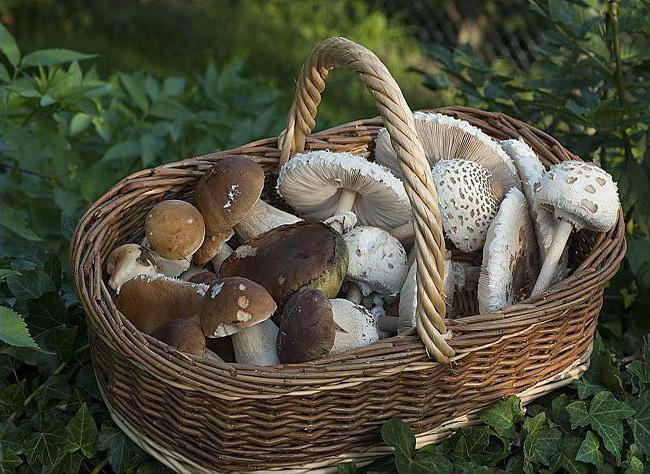
Description
A white-purple spider web is a small silvery mushroom with a damp or musty smell.

Hat
Size: reaches 8 cm in diameter.
Shape: at first it is bell-shaped, then the edges open, and the cap is transformed into a prostrate-convex one with a tuberous outgrowth. Specimens with an uneven surface are very often observed.
Color: initially lilac-silvery, then a yellowish-ocher coloration appears centrally, which fades almost to white in overripe specimens.

Surface: smooth and glossy, tacky in wet weather.
Leg
Size: in length it can reach 10 cm, and in thickness - up to 2 cm.
Shape: cylindrical, solid, often curved. Has a downward extension.
Color: white and lilac.
Surface: smooth. On the leg there is a ring-shaped growth of white or lilac color (there may be not one, but two belts).

Spore-bearing layer
Hymenophore type: lamellar.
Features: plates are serrated, rather frequent.
Color: in young specimens - silvery plates (with a blue or purple tint), in mature specimens - brownish or buffy.
Pulp
Density: rather soft, locally watery (in the leg).
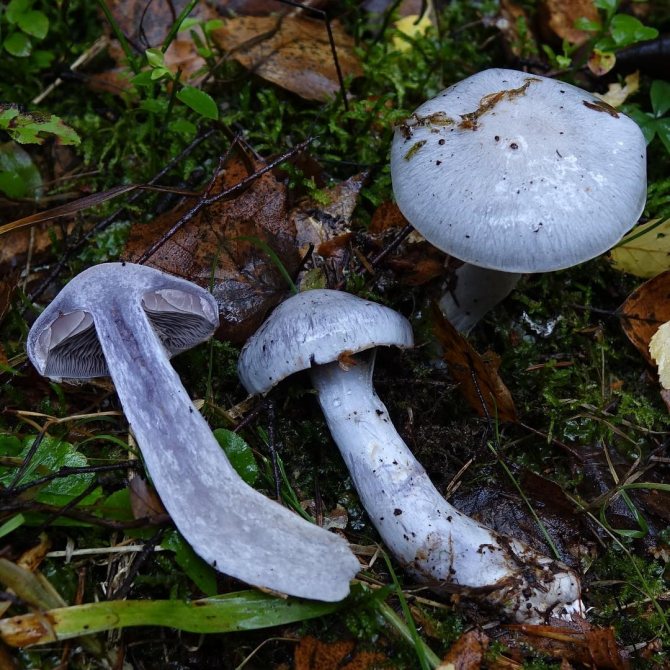
Color: in young mushrooms - pale blue, with age it acquires a brown color.
Smell and taste: the taste is not pronounced, the smell is unpleasant (musty).
Edible Spiderwebs Recipes
Not all types of pistils are dangerous to humans, but it is important to be able to distinguish between edible specimens. For example, an excellent webcap is a noble
mushroom, that's why it is recommended to fry it and serve it with any side dish
To prepare the dish, you will need the following products:
- mushrooms (500 g);
- wheat flour (4 large spoons);
- sunflower oil (3 large spoons);
- greens to taste.
Pre-boil fresh fruit bodies for 15 minutes, repeatedly draining the water. Next, cut them into small slices, fry in a pan until half cooked, mix with flour and continue to simmer the cobwebs for a few more minutes. It is recommended to use this dish hot.

Triumphal mushroom pickers collect cobwebs in order to marinate them. Take the following ingredients before you start cooking:
- boiled mushrooms (1 kg);
- black peppercorns (10 pcs.);
- bay leaf (3 pcs.);
- garlic (4 cloves);
- table vinegar (4 large spoons);
- sugar and salt to taste.
Boil the water, then add all the marinade spices and prepared cobwebs to the liquid. Boil the mixture for 15 minutes, then place the product in sterilized jars, season with vinegar and close the lids tightly.
The main symptoms and how quickly they appear
Thanks to a large number of studies, it has been determined that the main organ that attacks orellanin is the kidneys. Due to its joint effect with metabolites, free radicals arise in the cells of the epithelium of the kidneys, destruction of cell membranes, suppression of alkaline phosphatase and protein production, as well as damage to the structure of RNA and DNA.
Even a small amount of the product can cause harm to the body. 40 grams of freshly picked mushrooms eaten can be fatal. That is why, in order to save your life, it is recommended not to pay attention to the cobwebs of a brown-red hue, and not to collect suspicious mushrooms at all.
The clinical picture of orellanin syndrome largely depends on personal susceptibility to the toxin. In the case of poisoning by the most beautiful spiderweb, there are four stages of the disease.
The special danger of orellanin poisoning is that symptoms as a result of its ingestion may appear only after a long time, when it will be too late, and everyone will safely forget about the use of mushrooms. There are times when symptoms appear after 7-14 days. During poisoning, the patient may experience nausea, a great need to drink, a feeling of dryness and burning sensation in the oral cavity, vomiting, pain in the abdomen may occur. This condition can last from 1 to 2 weeks. If you do not seek help in a timely manner, then a lethal outcome is possible. In special cases, when the patient's condition is very serious, the onset of death can occur even 5 months after the moment the poisonous mushroom was consumed.
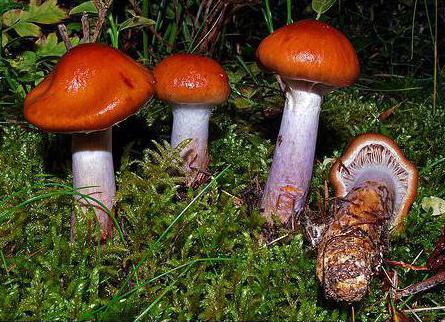
In the case of a short lethal stage, within 2-3 days, acute renal failure with a prolonged oligoanuric stage is formed. Children and the elderly are most affected by the disease.
If nephropathy persists for a long time, then in 30-50% of cases it will be followed by the formation of a chronic form of renal failure.
Poisonous doubles of the purple spider web
There are other purple-colored mushrooms in the forest. As a rule, these are non-poisonous mushrooms, but they are inedible. You can recognize the purple spider web due to the fact that its plates coincide in color with the cap.

Related species of purple spiderweb
Shiny webcap is a deadly poisonous mushroom. The cap varies from hemispherical to convex. Its surface is covered with mucus, and the center is fibrous-scaly. The color of the cap is chrome-yellow or sulfur-yellow, there may be reddish-brown spots. The pulp is sulfur-yellow or lemon-yellow. The aroma of the pulp is bready. The leg is bright yellow, with a thickened pubescent base.
Spiderwebs grow shiny in mixed and pine forests. They are widely baked in Europe, and in our country they are known in the Penza region. These mushrooms form mutually beneficial alliances with fir and spruce trees.
The blue-bore webcap is an edible mushroom. At first his hat is convex, and later almost flat. Its surface is slimy. The color of the cap is dark brown, ocher-brown or yellow-orange, sometimes there may be an olive tint. The leg is cylindrical, also slimy, white or purple. The pulp is whitish, tasteless and odorless. Blue-bore spider webs settle in coniferous and deciduous forests.

Toxic substances
The most beautiful webcap is a rare deadly poisonous mushroom that contains a very strong toxin, a complex polypeptide - orellanin. It does not lose its toxic qualities after being treated with high temperatures, placed in a different acidic environment and dried. The toxicity is greatly reduced only under the influence of ultraviolet and solar radiation. This mushroom contains 7.5 mg of orellanin for every 1 g of dried mushrooms.
Experts believe that in addition to orellanin, mushrooms contain 2 additional polypeptides - cortinarin A and B, which determine the totality of manifestations in the form of patient complaints. The joint presence of these 3 components was revealed only in 2 types of fungi of this family: the most beautiful cobweb (reddish) and orange-red.
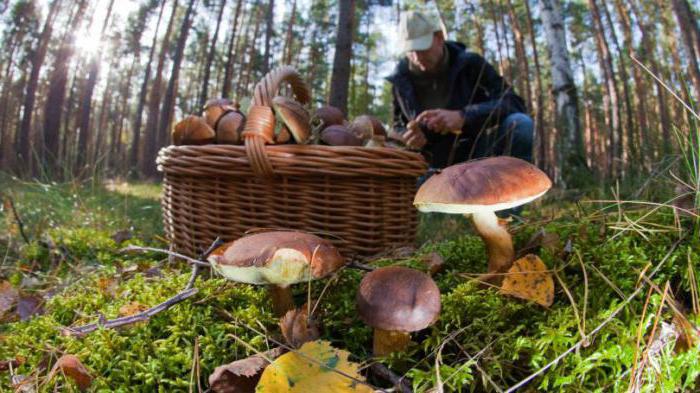
Varieties of edible spiderwebs
There are about 30 types of edible and inedible cobwebs. The rarest species are even listed in the Red Book.
Triumphal or yellow
The yellow spider web is considered one of the most delicious, therefore it can be found in various culinary recipes. The species got its name thanks to the yellow hat. In young fruits, it is round and elastic to the touch. Over time, the top flattens out and becomes almost flat, and the edges curl upward.
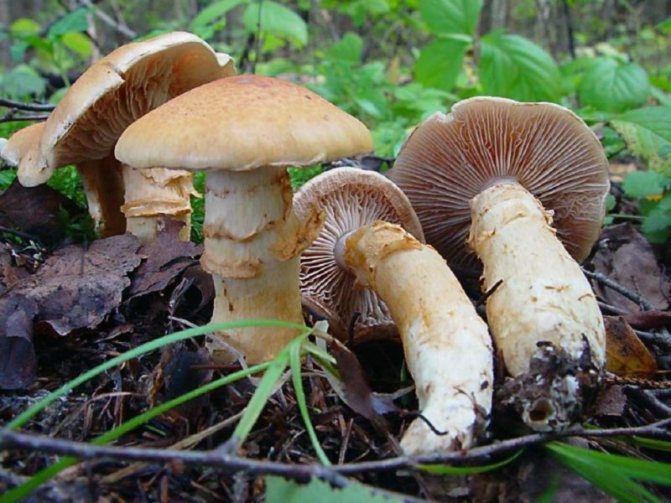
Triumphal webcap
The plates of the triumphant webcap are blue-white, eventually turning dark brown. The leg is high, thickened at the bottom. Has a lighter shade than the hat. In old sporocarps, the veil disappears, and the lower part is covered with red scales.
Excellent
The most popular species, often found in Russian forests. Young fruits have a round cap covered with a spider web. Gradually, the upper part straightens out and becomes a hemisphere, and over time it becomes completely flat.

The webcap is excellent
The top layer is dry and smooth and has a pleasant dark brown color. When it rains, it becomes covered in mucus and becomes sticky to the touch. The pulp is light, dense, with a pleasant aroma.
Dove blue
The watery blue pimple is of medium size and in adulthood can reach 10 cm in diameter. The shape of the cap depends on the age of a particular specimen and can be hemispherical or flat.

Webcap gray-blue
The leg is small, with an extension at the bottom. The hymenophore is lamellar, blue in young specimens, brown in more mature specimens. The interior has a bluish tint and an unpleasant odor.
Purple
The purple spider web is a rare species listed in the Red Book of Russia.It is rather large and can reach 15 cm in diameter. Like other varieties, the head of the purple pimple gradually changes, turning from spherical to flat.

Webcap purple
A distinctive feature of this species is a rich dark purple color. In mature specimens, it fades to a pale, almost white hue.
What does the spiderweb mushroom look like and where does it grow?
The name spiderweb means a genus of mushrooms of the family of the same name. Among mushroom pickers, the popular name pribolotnik is quite common, which reflects the peculiarities of the growth of the fungus. The mushroom got its main name due to the fact that at the junction of the leg and the cap it has a kind of cobweb, which practically disappears as it grows.
Interestingly, in appearance, different types of spider webs differ quite strongly, and novice mushroom pickers can take them for completely different families. There are fruit bodies of both classical shape and mushrooms with spherical and conical caps. The surface can be either dry or slimy, with a smooth or scaly texture. The color of the hats is also quite varied: yellow, orange, brown-red, burgundy and even white-violet.
Cobwebs grow alone, but more often in families from 10 to 30 pieces. They should be looked for in the lowlands, and they are collected mainly at the end of summer and until the onset of the first autumn frosts (late October in the European part of the country and the second half of September in Siberia).
Types of mushrooms and medicinal properties
Despite the fact that some of the types of spiderwebs are poisonous, this does not reduce the content of valuable substances in them, which are of practical use in medicine. Some of the representatives of this genus are used as raw materials for the manufacture of dyes. Mostly brown or ocher mushrooms are used for this.
Edible and conditionally edible representatives are successfully used for culinary purposes, having undergone additional processing in the form of prolonged boiling with frequent water changes. In cooking, such types of mushrooms are often used as watery blue spider web, excellent cobweb, purple cobweb, yellow cobweb.
These are the most common types of food. There are others, but many of them are useless and do not carry any flavor value. Be that as it may, even known species should be collected only by experienced mushroom pickers.
The most famous species of this genus are:
- yellow cobweb or triumphal spiderweb - edible;
- cobweb purple - conditionally edible;
- orange spider web - conditionally edible;
- crimson spider web - conditionally edible;
- the spider web is shiny - poisonous;
- bracelet cobweb - edible;
- changeable cobweb - conditionally edible;
- cobweb brown - conditionally edible;
- smeared cobweb - conditionally edible;
- the cobweb is excellent - edible;
- straight spider web - conditionally edible;
- reddish-olive spider web - inedible;
- cobweb cobweb - conditionally edible;
- scaly cobweb - inedible.
Webcap red
Red or blood-reddish mushroom, belongs to the category of poisonous. Bears close resemblance to the inedible purple spider web. Possesses pronounced antiseptic properties. The substances included in its composition prevent the development of tuberculous mycobacteria. Found in coniferous forests. Loves moist, mossy soil. Fruiting from July to September.
Typical signs of spiderweb poisoning are burning and dry mouth, intense thirst and subsequent vomiting, nausea, abdominal cramps. Often accompanied by headache and lumbar pain. Even if you notice the symptoms in time and consult a doctor, recovery and treatment will take quite a long time.
In order to protect yourself, it is important to remember the first rule of the mushroom picker: if there are doubts about the edibility or inedibility of the mushroom, then it is customary to consider it obviously poisonous. In general, it is better not to risk it and entrust the collection of webcases to specialists who can confidently distinguish a good mushroom from its poisonous counterpart.
Any type of poisoning requires immediate medical attention, before the arrival of an ambulance. It is advisable not to transport the patient to the clinic, as some toxins can cause disturbances in the activity of the cardiovascular system.
Before the arrival of the doctor, you should:
- put the patient to bed;
- carry out repeated gastric lavage;
- drink a laxative to remove poison from the intestines;
- make a cleansing enema.
If everything was done correctly, and the danger was noticed at an early stage, then after such measures, the victim in 2-3 hours can already feel an improvement in his condition.
Harm and dangerous properties
Some types of spider webs are highly toxic and poisonous. They are most dangerous because signs of poisoning with them can appear after a few days, or even weeks, since they contain delayed-action toxins. Their poison is very detrimental to the kidneys; with its help, a disease such as acute interstitial nephritis can develop. Even irreversible changes in the structure of the kidneys and death are possible. According to statistics, for seven cases of poisoning, one is fatal.
Typical signs of spiderweb poisoning are burning and dry mouth, intense thirst and subsequent vomiting, nausea, abdominal cramps. Often accompanied by headache and lumbar pain. Even if you notice the symptoms in time and consult a doctor, recovery and treatment will take quite a long time.
In order to protect yourself, it is important to remember the first rule of the mushroom picker: if there are doubts about the edibility or inedibility of the mushroom, then it is customary to consider it obviously poisonous. In general, it is better not to risk it and entrust the collection of webcases to specialists who can confidently distinguish a good mushroom from its poisonous counterpart.
First aid for poisoning
 Any type of poisoning requires immediate medical attention, before the arrival of an ambulance. It is advisable not to transport the patient to the clinic, as some toxins can cause disturbances in the activity of the cardiovascular system.
Any type of poisoning requires immediate medical attention, before the arrival of an ambulance. It is advisable not to transport the patient to the clinic, as some toxins can cause disturbances in the activity of the cardiovascular system.
Before the arrival of the doctor, you should:
- put the patient to bed;
- carry out repeated gastric lavage;
- drink a laxative to remove poison from the intestines;
- make a cleansing enema.
In case of poisoning, severe dehydration of the body occurs, so it is recommended that the patient be drunk with saline solutions, for example, rehydron. Give the victim cool strong teas or just salted water. With calf cramps, which often occur precisely due to dehydration, you can put mustard plasters on the lower leg.
If everything was done correctly, and the danger was noticed at an early stage, then after such measures, the victim in 2-3 hours can already feel an improvement in his condition.
The most beautiful webcap is a deadly poisonous mushroom
A photo of the mushroom in question is presented to your attention in the article. The most beautiful webcap (reddish) is a poisonous mushroom of the webcap genus, the webcap family. The people also call him a pribolotnik. They cannot be eaten either raw or cooked, because the toxins contained in them provoke the development of kidney failure. This genus consists of at least 40 species. Some are considered poisonous, some are edible, and some are conventionally edible. In appearance, such mushrooms are quite similar, which is why they are often confused. This suggests that it is better not to collect them without proper knowledge about both cobwebs and mushrooms in general. And in order to decide to eat such a mushroom, you need to be 100% sure what kind of cobweb you have found.
Until the 1950s, it was believed that these mushrooms could be eaten. And only as a result of a large number of incidents registered in 1957 with orange-red cobweb poisoning, and later the most beautiful cobweb, it was decided to include these mushrooms as deadly poisonous. It is these two species that are the most toxic.

Description of the mushroom
The common webcap, called in Latin Cortinarius trivialis, belongs to the family of Webcaps (or Cortinaria) and the genus Webcaps (agaric order). It is popularly known as Pribolotnik, as it grows mainly in wet areas. It acquired its name thanks to a kind of cobweb blanket, reminiscent of a veil-like film, which connects the edges of the cap with the leg. And the epithet "ordinary" symbolizes the classic, usual structure of the fruiting body and inexpressive color.
The cap of the mushroom reaches a diameter of 3 to 8 cm. In immature representatives of the species, it has a hemispherical, rounded-bell-shaped shape with curved edges. As the fungus grows, it becomes convex-outstretched with a wide, low tubercle in the center. At the same time, a small amount of mucus can be seen on the surface of the cap. The color varies from pale yellow or pale ocher with an olive tint to clay, honey brown and yellow brown. There are also fruiting bodies with a red-brown cap in the center and light edges.
The hymenophore (the lower part of the cap, on the surface of which there is a thin spore-bearing layer) is distinguished by wide, often located to each other, plates that grow together in the form of a tooth. In young mushrooms, this part has a yellow or whitish color, and in more mature ones, it is rusty brown or pale ocher. Also on the hymenophore, a barely noticeable cobweb cover of a whitish color with a mucous consistency is visible. The spore powder in the common spider web is yellowish-brown.
On the cut, the flesh of the mushroom is quite dense, ocher color (sometimes it acquires a light whitish tint), and closer to the base of the leg it becomes slightly brownish. The smell of the fruiting body is unpleasant, and the taste is inexpressive.
The leg of the common spider web is silky and dense. It has a cylindrical shape that tapers or sometimes widens towards the base. Its height is 5-10 cm, and its diameter is no more than 1-2 cm. In young representatives of the species, it is initially solid, and later becomes complete. The color of the leg is white, sometimes with a purple tint, brownish in the base area. The girdle on the stem resembles concentric fibers of yellow-brown and brown shades.
Brief description and habitat
Cobwebs are lamellar mushrooms. Their main distinguishing feature may well be their bright color. They are found in purple, bright yellow, dark red, terracotta and other colors. Some of the names of the species went precisely because of this feature of them: purple spider web, crimson spider web, watery blue spider web, and others. And the name of the whole genus of mushrooms was given by a cobweb film as a blanket enveloping its representatives. The spider web is clearly visible in young mushrooms: it connects the stem and the edges of the cap. And in mature representatives, a thin film breaks as it grows and becomes like a spider web entangling the leg of the mushroom. Some of its threads hang from the cap, but most of them remain in the lower part of the stem in the form of a cobweb ring. These mushrooms are very similar to each other and only experienced mushroom pickers can distinguish one type of cobweb from another.
All representatives of this genus have a round, flat cap as they grow, often raised in the middle. To the touch, it is smooth, fibrous, less often scaly. There may be both a mucous surface of the cap and a dry one. The pulp is fleshy, thin, often white, but it can be multi-colored. The plates are frequent, descending, and the stem is cylindrical, sometimes with a thickening at the base. The remains of a cobweb blanket will always be visible on it.It practically coincides in color with the surface of the cap, sometimes it can differ only in the intensity of the shade. Spore powder in mushrooms is usually yellow and brown-yellow in color. In general, cobwebs are very similar to, therefore, it is rather difficult to confuse them with edible mushrooms.
These mushrooms love moist, swampy soil. Often they can be found at the outskirts of bogs, which is why they got the name "pribolotniki". Cobwebs grow in deciduous and mixed forests, less often observed in conifers. It is a widespread genus. Their habitat is the European part of Russia, Siberia, the Far East, Ukraine, Belarus, Georgia and Kazakhstan. In Europe, they are often found in Austria, Italy, Great Britain, Belgium, France, Finland, Switzerland, Romania, Latvia and Estonia. You can also find them in the USA and Japan. However, although they are so ubiquitous, they are quite rare mushrooms. Some of their species, for example, the purple cobweb, are listed in the Red Book of the Russian Federation and other regions.
Common webcap (Cortinarius trivialis) what it looks like, where and how it grows, edible or not
Common webcap: photo and description
| Name: | Common webcap |
| Latin name: | Cortinarius trivialis |
| Type of: | Inedible |
| Specifications: |
|
| Systematics: |
|
The common webcap (lat.Cortinarius trivialis) is a small mushroom of the Cobweb family. The second name - Pribolotnik - he received for preference to growing conditions. It is found in wet, swampy areas.
A detailed description of the Common Webcap with photos and videos is presented below.
Description of the common webcap
The mushroom was called a cobweb for a kind of "veil" of a cobweb film that is present in young specimens. The rest of the appearance is unremarkable.
Description of the hat
Pribolotnik's cap is small: 3-8 cm in diameter. At the initial stage of development, it has the shape of a hemisphere, which is later revealed. The color of the cap ranges from pale yellow tones to ocher and light brown shades. The core is darker than the edges.
The cap is sticky to the touch, there is a small amount of mucus on it. The surface of the hymenophore is lamellar. In young fruit bodies, it is white, and in mature specimens it darkens to yellowish and brown tones.
The pulp is dense and fleshy, white, with a harsh odor.
Leg description
The leg is 6-10 cm in height, the diameter is 1.5-2 cm. Slightly narrowed towards the base. There are specimens with a reverse structure - there is a small expansion at the bottom. The color of the leg is white, closer to the ground it darkens to a brown tint. Above from the cobweb blanket are brown concentric fibrous bands. From the middle of the leg to the base - weakly expressed.
Where and how it grows
Podbolnik can be found under birches and aspens, rarely under alder. It rarely lives in coniferous forests. Grows singly or in small groups in damp places.
In Russia, the distribution area of the species falls on the middle climatic zone.
Fruiting from July to September.
Edible webcap common or not
The nutritional properties of the Common Webcap have not been studied, but it does not apply to edible mushrooms. This species cannot be eaten.
Related specimens contain dangerous toxins in the pulp.
Poisoning symptoms, first aid
The danger of toxic species of this family is that the first signs of poisoning appear gradually: up to 1-2 weeks after eating mushrooms. Symptoms look like this:
- intense thirst;
- nausea, vomiting;
- stomach ache;
- spasms in the lumbar region.
If you find the first signs of poisoning, you must urgently consult a doctor or call an ambulance.Before receiving qualified treatment, you need to:
- flush the stomach using activated charcoal;
- plentiful drink (3-5 tbsp. boiled water in small sips);
- take a laxative to cleanse the intestines.
Doubles and their differences
The podbolnik is confused with other members of the family, as they are quite similar. The greatest similarity is noted with the mucous webcap (lat.Cortinarius mucosus).
The hat is 5-10 cm in diameter. It has a thin edge and a thick center, abundantly covered with transparent mucus. The leg is slender, cylindrical, 6-12 cm long, 1-2 cm thick.
It differs from Pribolotnik in abundant mucus and the shape of a cap.
Grows in coniferous and mixed forests under pine trees. Bears fruit singly.
The slime webcap (lat.Cortinarius mucifluus) is another twin of the Pribolotnik, which is confused with the mucous webcap because of a similar name. The hat with a diameter of 10-12 cm is abundantly covered with mucus. The stem is 20 cm long in the form of a spindle, also covered with mucus. Prefers coniferous forests.
It differs from Pribolotnik in abundant mucus and a longer leg.
Conclusion
The common webcap is an inedible mushroom, its properties have not been fully studied. Can be confused with other members of the family, the use of which is not recommended. The greatest similarity is noted with the Slime Webcap and the Slime Webcap, but they can be distinguished by their cap. In the latter, it is abundantly covered with mucus.
Additional information about the common webcap:
Cobweb
Cobweb, a very widespread, poorly known mushroom. It cannot be called particularly demanding on the habitat. The webcap can grow in both deciduous and mixed forests. They tend to love moist areas. Very often, a spiderweb mushroom can be found along the edge of a swamp. Because of this, they got their second name "pribolotniki". But, in the fall, they can be found, even in places far enough from the swamps. There they can be found in quite large groups. Young cobwebs are very attractive in their appearance, a strong fleshy body, bright yellow in color. Their hat is rounded. Spore-bearing plates are hidden.
Adult mushrooms can resemble a toadstool. They have a darker color and the remnants of a bedspread that resembles a cobweb. These mushrooms are quite valuable and tasty.
The most important thing to know and be able to do is to distinguish them from other swamp mushrooms. Because among the variety of these mushrooms, there are also poisonous
Poisonous mushrooms can be distinguished by some signs, such as an unpleasant odor, a very bright color, and the legs of their bodies are mostly covered with scales. They also do not have the correct beautiful shape. They say that the best way to store this mushroom is by drying it.
Application
Cooking
Cobweb mushrooms are considered a delicacy, they have a great nutty taste. The fat woman is delicious fried or stewed with sour cream or cream. Decoctions from the bbw are used to make broth. Edible fruiting bodies are also pickled and dried, but this can lead to loss of most of the flavor.
An excellent webcap is dried or pickled only after a long soaking and boiling. Young specimens are suitable for pickling and salting. For your information. The shiny bloom on the crimson spiderweb cap disappears when dried.
Medicine
They are used to obtain probiotics and extract valuable microelements. In industry, dyes are extracted from colored fruit bodies. The species cannot be used in home medicine.
Among the people, spiderweb mushrooms that appear in the forests in late August - early September are called pribolotniki. This is explained by the fact that these fruiting bodies, growing in small groups, can often be found in swampy areas.
The mycological classification contains a description of about 700 species of spider webs, and in the international "Dictionary of mushrooms" there are at least 2000 of them.
September spiderwebs occupy more and more spaces. It is in September that the largest number of cobwebs can be seen.
Among them: white-purple, evening, smooth-skinned and others.They prefer slightly elevated places at the edges of the forest.

